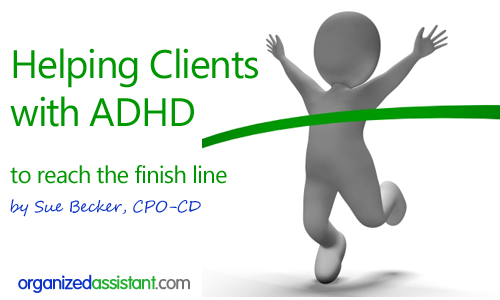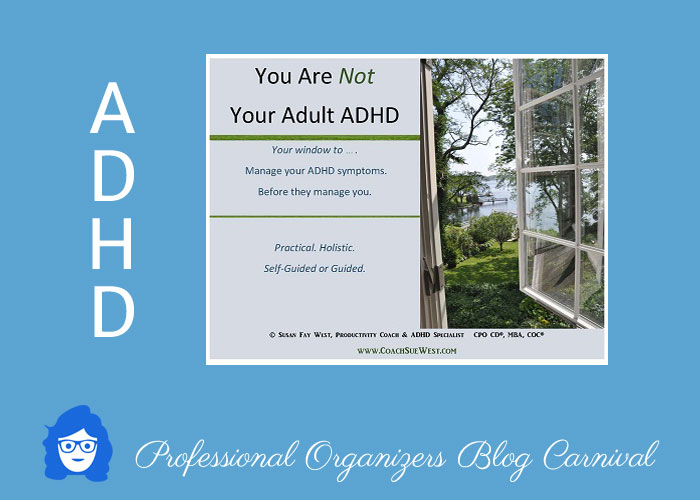Tips for Working with Clients with ADHD
This page may contain links to Amazon.com or other sites from which I may receive commission on purchases you make after clicking on such links. Read my full Disclosure Policy

Some clients are really easy to work with. Although they’re naturally organized, they occasionally need assistance getting back on track. Other clients are more difficult to help, especially if you don’t understand their unique challenges. I’ve invited Sue Becker, CPO-CD® and ADHD Specialist, to share some of the strategies that have enabled her to support her clients effectively.

Have you ever had a client who seemed easily distracted, talked excessively, or absolutely hated dealing with details? While anyone can exhibit these traits, they are common and persistent in people with ADHD (Attention Deficit Hyperactivity Disorder). I specialize in organizing adults in this population so I’m sharing here some things I’ve learned along the way that can help you in your work. By the way, the official name is ADHD, rather than ADD, whether or not someone has the hyperactivity component.
ADHD is a neurobiological difference in the brain that affects “executive function”, the part of the brain that controls the processes of self- regulation (impulsivity), memory, focus, decision-making and planning. Because all of these skills are important in the organization process, it’s easy to see why organization and time management can be a challenge for people with ADHD.
There is no simple test to determine if someone had ADHD – diagnosis should be done by a professional who specializes in this area and should include a personal history from the patient, collaborative information from friends and family, as well as psychological tests.
There is often a lot of emphasis on, and controversy about, using medication to treat ADHD. Whether or not your client takes medication, they may still have to put forth more effort than others might in order to establish organizing habits.
Many of my clients with ADHD weren’t diagnosed until their kids were diagnosed (there’s a strong genetic link to ADHD), especially if they don’t have the hyperactivity component that might have tipped people off when they were younger. These clients sometimes experience shame, guilt, or even grief about the diagnosis – they imagine how much easier their life could have been if they’d been diagnosed sooner. In some situations it might be appropriate to suggest the help of a therapist to work on these issues (tread lightly here).
Educate yourself, and offer your clients resources to educate themselves, about ADHD. Here are three of my favorite resources:
- CHADD provides information and support for people with ADHD, as well as their parents, caregivers and spouses.
- ADD Friendly Ways to Organize Your Life by Judith Kolberg and Kathleen Nadeau –Offers helpful organizing and time management techniques for people with ADHD.
- The Institute for Challenging Disorganization offers teleclasses that are available to both members and nonmembers, and also offers an ADD Specialist certificate.
Help your clients identify and implement habits that support a healthy lifestyle – exercise, sufficient sleep, and good nutrition. While these are important practices for all of us, they’ve been shown to mitigate some of the negative characteristics of ADHD.
Help your clients discover and celebrate what they’ve done well. People with ADHD tend to be hard on themselves, due at least in part to the frustration and disappointment they’ve experienced in the past. Praise them for even the smallest accomplishments and encourage them as they experience the ups and downs of establishing new habits.
Try unconventional organizing methods. I’ve found my clients with ADHD to be very visual – out of sight equals out of mind. Tap into their creativity to find ways to add structure while honoring their need to have things visible.
Finding the right system may involve some trial and error, and this is a normal part of the process. Help them tweak things until you find a solution that works consistently for them.
They may forget to follow the system you’ve established, so be sure to document it and help them put it in places that will remind them to follow it. You may want to follow up with phone calls and/or e-mails to remind them as well. Remind them that setbacks and backsliding are a normal part of the process.
Here’s to you success in working with clients with ADHD – enjoy their intelligence, sense of fun, willingness to learn, and appreciation of your help.
Image courtesy of Stuart Miles at FreeDigitalPhotos.net



